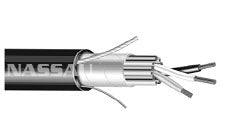
Product Details
| Technical Specifications: | |
| Catalog Number | HW111 2012E |
| Size AWG | 20 |
| No. of Pairs | 12 |
| Insulation Thickness Mils | 15 |
| Jacket Thickness Mils | 50 |
| ANSI Type | E X |
| Overall Diameter | 0.61 |
| Net Weight Lbs/Mft | 195 |
Specifications:
- HW111
- Thermocouple Extension Cable
- 150 Volt UL Type PLTC & ITC, 105°C
- Single and Multiple Pairs
- Overall Shield
- PVC Insulation
- PVC Jacket
- Solid Alloy Conductor
Application:
For use in thermocouple extension applications where protection from electrostatic interference is required. UL listed as Type PLTC and approved for installation indoors or outdoors, aerially, in conduits, ducts and cable trays in circuits not exceeding 150 volts. May be used in NEC Class 1, Division 2 hazardous locations.
Conductors:
Annealed, solid thermocouple extension-grade alloys calibrated to standard limits of error per ANSI-MC96.1.
Insulation:
Flame-retardant PVC per UL Standard 13, color coded per ANSI-MC96.1.
Communication Wire:
Multipair constructions contain a 7-strand bare copper orange PVC-insulated communication wire.
Overall Shield:
Aluminum-polymer tape providing 100% coverage with a flexible 7-strand tinned copper drain wire.
Jacket:
Sunlight-resistant PVC color coded per ANSI-MC96.1. A ripcord is applied longitudinally under the jacket to facilitate stripping.
Flame Tests:
UL 1581 70,000 BTU/hr flame test
Additional Standards:
NEC Type ITC approved for use in hazardous locations per Articles 501, 502, 503 and 504
